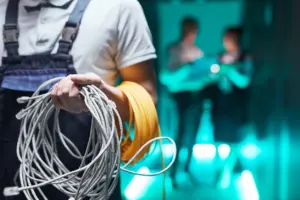The Best Technique for Effective Noise Control
In busy work environments, controlling noise and maintaining speech privacy can be a challenge. Effective noise control is essential for maintaining productivity, comfort, and privacy. Various strategies address this issue, each with its own advantages and limitations. Understanding these techniques can help you decide the best solution for your space.
One method often considered to mitigate sound is sound masking, which reduces the perceived distraction of unwanted noise. Sound masking, although similar, differs from soundproofing. While soundproofing blocks sound from entering or leaving a space, sound masking adds a subtle background sound to mask unwanted noises. This is particularly effective in open office plans where distractions can reduce efficiency. Other techniques include acoustic panel installations, and environmental design modifications. The proper solution depends on your specific needs and environment.
While these techniques are valuable, you’ll see as we delve deeper into sound masking how this method offers a versatile and cost-effective solution, especially compared to extensive soundproofing. The following sections will explore how sound masking works, its benefits, and why it’s an excellent option for noise control in various settings. Understanding these differences will help you decide if sound masking is right for you.
White Noise Machines
White noise machines are affordable and easy-to-use devices that are intended for small office spaces, private workspaces, and homes. These devices work by producing a consistent sound that covers other noises, helping to create a more focused and tranquil environment. They offer several benefits such as affordability, ease of use, portability, and a variety of sound options, which can include nature sounds, fan noises, and ambient tones. This makes them a versatile choice for those who need a little extra help in maintaining concentration or achieving better sleep.
However, white noise machines are not without their limitations. Their effectiveness can be reduced in larger areas where the sound may not cover the entire space adequately. Additionally, the constant noise they produce at the same frequency can become irritating to some individuals over time. The quality of the sound can also vary between different models, which means that not all white noise machines may meet users’ expectations. Furthermore, these devices are dependent on power sources, whether through batteries or electrical outlets, which could be inconvenient in situations without easy access to power.
While white noise machines offer a convenient solution for sound masking in smaller spaces, they may not be sufficient for larger spaces or more complex acoustic environments. In such cases, additional sound control measures, such as acoustic panels, professional soundproofing, and/or professional sound masking may be necessary to achieve the desired level of noise reduction.
Ceiling and Wall Panels
Acoustic panels, installed on ceilings and walls, effectively control noise by absorbing sound waves and reducing reverberation in an effort to muffle sound. Key materials include foam, fiberglass, wood, wool , and polyester fiber, each offering unique benefits in sound absorption and aesthetics. Design options like baffles, clouds, wall-mounted, fabric-covered, and perforated panels cater to various settings, enhancing both acoustics and visual appeal. Proper selection and placement of these panels can significantly improve sound quality and manage noise levels in different environments.
Depending on the type and number of acoustic panels required in a space, this option can be cost prohibitive. Additionally, some designers do not like the aesthetic appeal of acoustic panels, and prefer to use more technology-focused sound mitigation techniques, such as sound masking.
Sound Masking Systems
Deploying sound masking is another great way to reduce unwanted sounds and increase speech privacy. Installing a specialized sound masking system designed to provide the most effective solution for managing and mitigating unwanted noise is the one of the best ways to reduce noise distractions. These systems are engineered to create an evenly distributed sound field that seamlessly integrates with the ambient background sound, ensuring a consistent and unobtrusive masking effect.
One notable example of unobtrusive sound masking is Lencore’s trademarked Green Sound®. This innovative technology offers a sophisticated approach, addressing the specific needs of various commercial, healthcare, and government spaces. Lencore’s Green Sound generates a unique spectrum of sound that is both effective at masking unwanted noise and pleasing to the ear, promoting a comfortable and productive environment. This advanced system is designed to blend perfectly with the surrounding background acoustics, maintaining speech privacy and reducing distractions.
Implementing Sound Masking Techniques
In Office Environments
Implementing sound masking techniques in office environments requires careful planning and consideration of various factors to achieve optimal results. Begin by evaluating the office layout. Open-plan offices, cubicles, and private offices each have unique acoustical needs. In open-plan spaces, consider clustering workstations into groups and using partitions to create smaller, defined areas that can better manage sound. For private offices, ensure that any sound masking system installed is calibrated to maintain speech privacy during conversations.
It is also important to utilize a mix of sound masking strategies to address different noise sources and acoustic challenges effectively. Integrate sound masking with acoustic panels on walls and ceilings. The combination will help address various frequencies of noise and prevent excessive sound buildup.
Another great way to reduce sound in offices is to designate specific areas as quiet zones where employees can work without interruptions. These zones should incorporate extensive sound masking measures, including a high-quality sound masking system and more intensive use of acoustic panels, to maintain a peaceful environment.
Properly designing and tuning a professional sound masking system after it is deployed ensures its effectiveness and its optimal function. Periodic recalibration may be necessary to adapt to changes in the office layout or occupancy levels. By thoughtfully combining and implementing these techniques, office managers can create a balanced auditory environment that enhances employee concentration, productivity, and overall satisfaction.
In Healthcare Settings
Proper implementation of sound masking in healthcare settings is crucial for enhancing patient privacy and comfort. Not only does it help in creating a quiet environment conducive to healing, but confidentiality via sound masking also ensures compliance with various healthcare regulations related to patient confidentiality.
Sound masking systems can significantly improve patient privacy by reducing the audibility of conversations and medical discussions in healthcare facilities. Protecting speech privacy is particularly important in environments such as hospital wards, outpatient clinics, and consultation rooms where sensitive information is frequently exchanged. By introducing a uniform sound field, sound masking can ensure that conversations are not overheard, thus maintaining patient confidentiality and adhering to regulations such as the Health Insurance Portability and Accountability Act (HIPAA) in the United States. HIPAA mandates stringent measures to protect patient information, and sound masking can be an effective solution to meet these requirements.
Patient comfort is also greatly enhanced through the use of sound masking. Hospitals and clinics are often bustling with activity, which can be distressing for patients trying to rest and recover. Sound masking can mitigate the impact of ambient noise, creating a more tranquil environment. This is especially beneficial in patient rooms, waiting areas, and recovery wards, where a peaceful auditory environment can contribute to better rest and quicker healing processes.
To effectively implement sound masking in healthcare settings, you must evaluate the specific acoustical challenges of each area within the healthcare facility. Different spaces will have varied requirements based on their functions and the level of noise they generate. Install sound masking systems in strategic locations to maximize effectiveness. For instance, placing sound masking devices near waiting areas, nurses’ stations, and corridors can help reduce the transmission of noise throughout the facility. By adhering to these best practices, healthcare facilities can successfully integrate sound masking solutions to improve patient experiences, bolster privacy, and create a more comfortable and compliant environment.
In Public Spaces
Sound masking plays a vital role in public spaces such as libraries, cafes, and airports, where balancing noise levels is essential for various activities. These environments require careful acoustical management to ensure that patrons can enjoy a comfortable and functional auditory experience.
In libraries, maintaining a quiet and conducive environment for reading and studying is paramount. Sound masking helps mitigate distractions from conversations, footsteps, and other ambient noises, allowing patrons to better focus. For example, the Seattle Public Library successfully implemented a comprehensive sound masking system that creates a soothing sound field, significantly reducing noise disruptions and enhancing the overall user experience.
Cafes often serve as multipurpose venues where people meet to socialize, work, or relax. Proper sound masking in cafes can help manage the diverse soundscape, ensuring that the environment remains pleasant and inviting. A notable instance of effective sound masking can be seen in the Soho House coffee shops in London. These cafes use a mix of background music and sound masking technologies to create a balanced ambiance that supports conversation while minimizing intrusive noises.
Airports are bustling hubs of activity, and managing noise levels is crucial for maintaining passenger comfort and communication clarity. Sound masking in airports helps reduce the impact of public announcements, luggage handling, and general crowd noise. Hartsfield-Jackson Atlanta International Airport, for example, has employed sound masking solutions in its lounges and waiting areas. This approach has created a more tranquil atmosphere for travelers, improving their overall airport experience.
By implementing sound masking strategies tailored to the unique needs of libraries, cafes, and airports, these public spaces can significantly enhance the comfort and satisfaction of their users. Successful examples demonstrate that thoughtful acoustic management can transform noisy environments into peaceful, functional spaces.
Implement Effective Sound Masking with Lencore’s Sound Masking Solutions
Lencore’s flexible sound masking solutions stand out for exceptional quality and effectiveness in addressing the unique acoustical needs of various environments. With decades of experience in the field, Lencore combines cutting-edge technology with a deep understanding of sound dynamics to deliver tailored solutions that enhance privacy, comfort, and productivity. Whether it’s a healthcare facility, public space, or corporate environment, Lencore’s advanced systems are designed to seamlessly integrate and improve the auditory experience.
Our team of experts is dedicated to providing personalized consultations to ensure that our sound masking solutions meet your specific requirements. We pride ourselves on our commitment to excellence and customer satisfaction, which is reflected in our robust product performance and comprehensive support services.
Take the first step towards creating a more acoustically optimized space by exploring what Lencore can offer. Receive a quick estimate to discover the perfect solution for your environment today.
Check Out Our Other Articles

The Science of Habituation and Office Noise Reduction Through Sound Masking
In the modern workplace, distractions are everywhere: conversations across the hall, the ping of a notification, and the hum of HVAC systems. This noise in the workplace contributes to constant interruptions and environmental stressors. But beyond irritation,

Maximize Your Investment: Integrate Paging into Your Sound Masking System
When a client starts planning for a sound masking system, they are usually focused on reducing distractions and improving speech privacy. But if you are already investing in a system that reaches every corner of your space,

Master Certified Installer Spotlight: Sean McGrath of Birkstone Services
When it comes to creating comfortable, private, and productive workspaces, sound masking has become a crucial part of modern building design. Few understand this better than Sean McGrath, owner of Birkstone Services, a structured cabling company with
